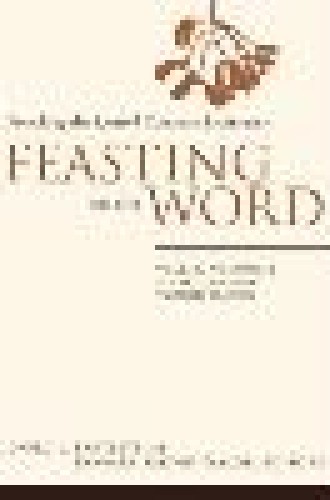Text messages
Though it has long since disappeared into the electronic traces of deleted e-mail, I still cringe to remember it: my breezy appeal for an exemption from Introduction to Homiletics. I explained that as a college professor of some 20 years I was well accustomed to writing and public speaking and that I had already preached a few times in my home congregation. “I know I have a lot to learn,” I admitted, but went on to opine that I could do that on the job without the help of an introductory course in what I called “homeletics.” The professor politely replied that no exemptions were allowed for the course, forbearing to mention that a person who could not even spell homiletics might find something to learn in a seminary course on the subject.
Though that course gave me a glimpse of just how much I had to learn, only with the humbling experience of my first call, when I became immersed in weekly sermon preparation, did I begin to realize the daunting scope and demands of preaching. Since then, I’ve finished my first round of the three-year lectionary with both a sense of accomplishment and a renewed appreciation of the inexhaustible riches of God’s word.
When I undertake the solitary task of sermon preparation each week, I am accompanied in imagination by those who will hear me, I study the texts with a colleague group, I exchange sermon drafts with two other preachers and a friend who is a poet and scholar, and I am grateful for the exegetical, theological and homiletical resources of many people whom I know only through their published work.
Feasting on the Word is a monumental contribution to that body of work. These substantial and beautifully produced volumes address the reader with all the gravitas and grace that preaching deserves (and requires). Here are companions along the way; or, to keep with the metaphor of the series, here is food for the journey.
Organized to accompany the Revised Common Lectionary, Feasting offers four essays on each of the four weekly readings, for a total of 16 every week. Each set of four essays—one written from a theological perspective, another from a pastoral perspective, and the other two from an exegetical and a homiletic perspective—are printed side by side, in four columns across facing pages. The editors have gathered an impressive roster of writers, and the result is a lively collection of thoughtful and well-written pieces, many of which directly address preachers, offering a bracing blend of admonition, exhortation and encouragement.
In my sermon preparation, I have chosen to read all of the essays each week, and it is a feast indeed. Reading the 24 densely printed pages requires a fairly steep commitment of time, and the layout takes some getting used to. By printing the essays side by side, the editors have resolutely refused to foreground one approach over another. Still, I find it distracting to keep flipping back and forth.
At first I was skeptical of the separation of theological, pastoral, exegetical and homiletic perspectives, but the approach works surprisingly well. Whether because of careful instruction to the writers, thoughtful editing or both, there is virtually no overlap among the essays. Consider, for example, the treatment of the Christmas Day Gospel reading, John 1:1-14. Cynthia L. Rigby plumbs the theological depths of the prologue with a series of questions about its mysteries even as she calls the preacher to a clear proclamation of the text’s central claim: “The real Word really became real flesh.” The pastoral perspective supplied by Ashley Cook Cleere acknowledges the difficulty of preaching on a day that may feel anticlimactic after the full services of Christmas Eve, and she discusses the further challenges of John’s poetic abstractions. She notes the appeal of John for “more cerebral congregants” as she reminds the preacher to proclaim the gospel in a way that addresses a variety of hearers, “to touch the hearts of all who are present.”
Lewis R. Donelson, writing from an exegetical perspective, considers the connections to the creation narrative and deftly argues that the text’s evocations of creation theology resolve the apparent dualism of the prologue. In her contribution from a homiletic perspective, Kimberly Bracken Long exhorts the preacher to face the challenges of the prologue forthrightly by proclaiming the incarnation not as a theological conundrum but as lived experience—as Christ encountered in word and sacrament, in one another and “in the ordinary moments of our lives.” Each of these four essays can stand alone; taken together, they complement one another and open many paths into the preaching of the word.
At times, writers on the same text set forth divergent or contradictory interpretations, bearing witness to the many and various ways in which the biblical word is heard. For example, two writers propose different directions for the preacher as they consider the unsettling eschatology of 1 Corinthians 7:29-31 (third Sunday after Epiphany), in which the apostle proposes a startling series of reversals, beginning with “let even those who have wives be as though they had none” and concluding with an exhortation to “deal with the world as if they had no dealings with it.” Douglas F. Ottati wrestles with the difficulties this reading presents for contemporary hearers and concludes that it provides an occasion for preaching against the text: “Paul finally fails to recognize with sufficient seriousness that God’s good world appropriately does make claims on us.” Pondering the same pericope, Ruthanna B. Hooke finds pastoral value in the urgency of its eschatological claims; for her, the reading offers a salutary perspective on the ultimacy of God’s reign and a sense of immediacy that might spur Christians to deeper discipleship.
Feasting on the Word is less sensitive to liturgical occasion than sources such as Sundays and Seasons (Augsburg For tress), which includes suggestions for worship planning and brief topical ideas for preaching. Compared to most other sources, Feasting offers more depth and range of commentary on each reading and psalm, but the organization precludes reflection on the relationship between the readings. Preachers will need other means to ponder the rich juxtapositions of the lectionary. That is the strength of a work written in a single voice, like Fred Craddock’s in dispensable three-volume Preaching Through the Christian Year (Trinity Press International) or a source like New Proclamation (Fortress), which includes the work of a handful of writers, each of whom provides commentary for several weeks or a liturgical season.
This series is designed as a reference source that will have a permanent place in the preacher’s library. Each volume is printed on acid-free paper and has sewn binding. Copper lettering on the oatmeal-colored cloth cover lends a quiet elegance, and the cream-colored pages are printed in sable ink. The design is austere, with columns of type unbroken by graphics and with sparing use of white space, likely because of cost considerations. Though at $39.95 each, the books are fairly priced, purchasing the 12 volumes of the complete series is a hefty commitment. But go ahead, take a deep breath and commit. Feasting on the Word will richly repay your investment.






